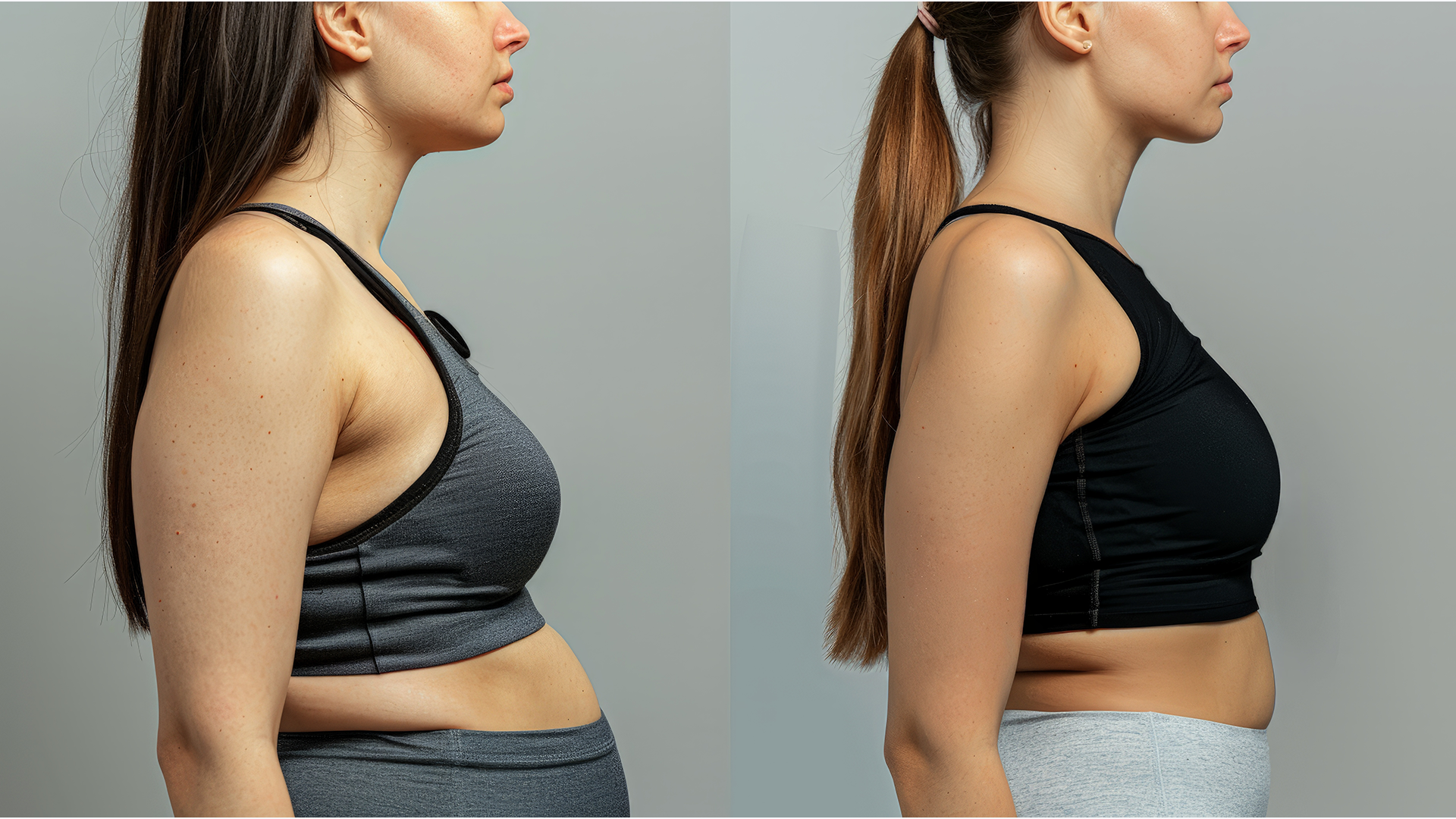Things you’ll learn in this blog |
When most people want to lose weight, they go on a diet.
It’s what we’ve all been told for years – that the best way to shed the pounds is to starve ourselves and eat mostly salad.
But this approach can leave you feeling miserable and hungrier than ever, which means in all likelihood that you’ll want to quickly give up, just to start again in a few week’s time when you feel guilty about quitting – this is known as yo-yo dieting and is something that we are all no doubt familiar with.
Fortunately, there is a better way!
It doesn’t involve making huge sacrifices in a short amount of time or making promises that are impossible to live up to. You just need to make tiny changes that you can implement into your current lifestyle.
If you can set realistic goals and develop healthy habits, you are far more likely to stick to a new way of living than if you try to force yourself to follow arbitrary rules that you dread the thought of.
One of the biggest cheat codes you can use to be able to eat nice food and lose weight (without going hungry) is to track what you eat.
All you have to do is calculate your daily calories and split it down into macros – don’t worry, this is far easier than it sounds.
Let’s go through this together so that you have all the information required to build your own diet plan that includes the foods that you actually want to eat.
Why you should calculate your daily calories
We hear about calories all the time. You’re out for dinner, and your friend avoids the pasta because “there are too many calories in that”.
You pick up a bar of chocolate, and the calorie information is right there on the packet, just waiting to be studied (or, more likely, ignored).
But what does it all really mean?
We all think about ways to cut calories from our diets blindly, but without paying any real attention to what the numbers are actually about.

A simple way to look at it is that food is the fuel that keeps us going, and calories are how we measure it. So if we input too many calories, we’ll store them as body fat.
The general guidelines for how many calories are required each day is 2000 for women and 2500 for men. This is fine as a starting point but is a bit too simplistic – we are all completely different.
Some of us are ectomorphs; some are mesomorphs, and others are endomorphs. We’re all different heights, weights, and ages. We have differing goals, and our metabolisms vary. So, the suggestion that we all require the same amount of calories doesn’t really make sense.
Just as we choose clothes to fit our own personal dimensions, we should really be eating the exact amount of calories that suit our individual proportions and body types.
This is the way to start if you want to make real, lasting changes to your body weight.
We all know that if you consume more calories than you burn on a regular basis, you will gain weight. But if you eat at a calorie deficit, you can lose weight. However, the amount of calories you burn will vary depending on your activity levels and your metabolism – which brings us back once again to our somatotypes and how our bodies react to food and exercise.
The keywords that bear repeating here are “on a regular basis”. You shouldn’t feel guilty or think that your plans are in ruins if you eat more than your recommended calorie intake now and again. As long as it doesn't happen regularly, then it’s not the end of the world – we all slip up sometimes, and we all deserve to treat ourselves on occasion.
Minor differences soon add up, though, so making sure you are on the right side of the line more often than not across the weeks and months is the way to achieve steady weight loss.
Weight gain happens over a period of time (often without us realizing it), so it won’t happen overnight if you do backslide on the odd occasion. The same goes for losing weight – little steps make for big changes.
That’s why it is crucial to determine how much you should be eating each day – so you have something to aim for and stick to consistently.
Let’s take a look now at how to calculate the optimal amount of calories (and macros) you should be eating each day for healthy and sustained weight loss for your body type.
How to calculate your calories
Step one in working out your calorie needs is to figure out how much energy you typically exert on a normal day.
Once you know how many daily calories you burn, you can see how many you will need to consume to lose weight – making sure to take into consideration what your somatotype is and what your fitness goals are.
If the idea of doing calculations worries you, then have no fear; there are no complex equations or advanced math required on your part (unless you really want to) – we’ve got a handy little tool that does it all for you: a TDEE calculator.
Using a TDEE calculator
Before jumping into the calculations, let’s quickly define the term TDEE.
TDEE stands for your Total Daily Energy Expenditure.
Your TDEE doesn’t just measure the calories that you burn during bouts of exercise; it also includes the energy that is used by your body to complete its usual daily functions.

There are countless biological actions constantly going on inside your body, things related to digestion, breathing, circulation, and many other underlying processes that are outside of conscious control – and they all require energy to keep running. So these are taken into account by TDEE, as the food you consume is the source of power for them all, not just for exercise.
The number of calories you burn due to these processes is known as your Basal Metabolic Rate (BMR). This is not to be confused with BMI (your Body Mass Index), which measures your weight compared to your height – and isn’t actually that useful a metric.
Determining your TDEE is simple; all you need to do is put the following information into an online calculator:
- Age
- Gender
- Height
- Weight
- Activity level (just choose from one of the options provided)
Many TDEE calculators online are free to use, and most of them allow you to input your weight and height in metric or imperial measurements, whichever you are more familiar with.
Once you’ve popped your information into the calculator, it will work out your TDEE for you.
It really is that easy!
However, just in case you like to see exactly how the calculator arrives at your given number, we’ll run through it step by step as well (feel free to skip to the next part if you’re happy just to know your TDEE).
There are many different equations that can be used to work out your BMR and TDEE manually. One of the most popular is the Mifflin-St. Joer formula and that is what we’ll use here (it’s also the one used by the calculator linked to above):
- For women: (10 x weight in kg) + (6.25 x height in cm) – (4.33 x age in years) – 161
- For men: (10 x weight in kg) + (6.25 x height in cm) – (5.68 x age in years) + 5
This formula provides your BMR, which you can now multiply by one of the following numbers based on how much activity you tend to partake in during a normal week:
- Sedentary lifestyle (little or no exercise) = BMR x 1.2
- Lightly active (light exercise/sport 1-3 times per week) = BMR x 1.375
- Moderately active (moderate exercise/sport 3-5 times per week) = BMR x 1.55
- Very active (hard exercise/sport 6-7 times per week) = BMR x 1.725
- Extremely active (hard exercise/sport 6-7 times per week, plus physical job) = BMR x 1.9
As with the BMR equations, these numbers may be slightly different depending on the source you use, but the ones above are probably the most common and useful to apply.
Let’s go through one example in full so you can see exactly how it works:
We’ll use a 40-year-old, 165cm tall woman weighing 60kg as an example (let’s call her Jenny). Her statistics would give us the following:
(10 x 60) + (6.25 x 165) - (4.33 x 40) - 161
This works out to be:
600 + 1031.25 - 173.2 - 161 = 1297.05
If we also say that Jenny is lightly active (she particulates in light exercise around 1-3 times per week), our final calculation gives us:
1297.05 x 1.375 = 1783.44
Rounding this to a nice easy number of 1800 calories, this is how much Jenny should consume daily.
Working out your BMR and TDEE may seem a bit more complicated when written out like this, so we recommend sticking with the online calculator if this feels intimidating.
Something that you might have noticed is that Jenny’s recommended calorie intake is less than the general 2000-calorie guideline that we often hear about.
This is why it is so important to make a calculation using your own individual statistics – if Jenny were to blindly follow the standard recommendation, then she would actually gain weight!
A starting point of 1800 calories per day is much more preferable. From this baseline, Jenny could then tweak how much she eats per day if she isn’t getting the desired results.
One of the ways to do this is to adjust her macro ratios, which is what we’ll look at next.
What are macros (and how do you calculate them)?
By now, you hopefully know how many calories you should be eating each day, so we just need to break those calories down one step further into macros.
We’ve mentioned that word a couple of times already, but what does it actually mean?
If you aren’t familiar with the term macros, don’t panic – all it refers to is the three macronutrients (fat, protein, and carbohydrates) and how you split them across meals and snacks.

Tracking your macros is a key component to creating a healthy diet, as each macronutrient provides different but vital benefits for your body.
Not all calories are created equal, either. Eating the perfect amount of calories is all well and good, but not if they all come from chocolate cake (no matter how much we might dream of this!). It’s crucial that you consume the right blend of carbs, protein, and healthy fats.
Each macronutrient also contains a particular amount of calories per gram, which we will take into account when putting together your personal meal plan. As a quick preview:
- Protein = 4 calories per gram
- Carbohydrates = 4 calories per gram
- Fat = 9 calories per gram
So that’s what macros are, but what sort of breakdown should you be looking at?
To stick with Jenny as our example, those 1800 calories that were recommended for her weight, height, age, and activity levels are how much she should eat each day if she wants to maintain her current shape.
For weight loss, the number needs amending.
A good starting point if you are looking to lose weight is to trim 10-20% off of your daily calorie intake. This safe and healthy cut will lead to steady weight loss.
For Jenny, a nice round number that is easy to follow would be 1500 calories per day. This is an ideal amount to consume each day based on her recommended maintenance number.
Now we’ve determined the daily intake; we can take the final step and break down those 1500 calories into macros.
How you split your macros up will depend largely on your goals, activity levels, and your somatotype.
If you were looking to maintain your current weight, a popular percentage split of your macros could look like this:
- 40/30/30 (carbs/protein/fats)
This is as good a place as any to start tweaking from based on your somatotype – you can increase and decrease the macros as required as you learn more about how your body responds to a particular ratio.
For example, if you are an ectomorph, your natural capacity to burn calories quickly will allow you to consume more carbs than other somatotypes. Therefore a percentage split of 45/35/20 (carbs/protein/fat) would be well suited to your high carb tolerance and faster metabolism.
For mesomorphs, sticking to that established 40/30/30 ratio is ideal for your more athletic physique – it would just be the actual calorie count that you change (e.g. 1500 instead of 1800 per day).
Finally, for endomorphs, lowering your carb intake but increasing your consumption of protein and healthy fats is a smart way to approach weight loss. A 20/40/40 split is a better ratio for your low carb tolerance and slow metabolic rate.
These are all just guidelines, though. Use this as a starting point, then reassess after a couple of weeks to see if further amendments are required. Nobody knows your body as well as you do, so listen to what it tells you and pay attention to how you are feeling.
This might all seem like an overwhelming amount of information to take on board, but you only have to do this once – from here on out, it is just minor tweaks and adjustments whenever they may be needed.
Now that you’ve determined your somatotype, calorie count, and ideal macro splits, you are in such a powerful position. This is the knowledge that you can take forward and apply to your life forever.
Trust us, in doing this, you have catapulted yourself so far ahead of most other people and put yourself in the best place possible to burn fat and hit your fitness goals.
It’s not a diet; it’s your new lifestyle. You are fit and healthy – that’s how you should be able to view yourself once you apply this to your daily life.
And now that all the calculations and hard work is out of the way, we can move on to the fun stuff: putting together a delicious and nutritious meal plan that is designed to shed the pounds!




